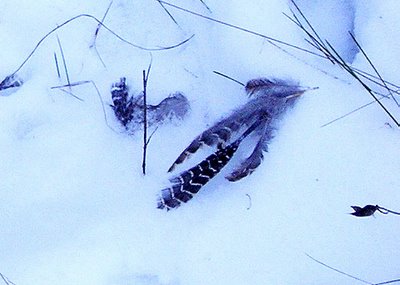Since then we've had a thaw and another little sprinkle of snow--we now have just a couple of centimetres, and patchy. Under these conditions there are clues left by animals passing through or getting up to stuff, but no stories written in the snow. But back then, that first real snow, it was all there.
I went out into the field and was immediately rewarded by the sight of a set of fox tracks leading into the stand of young pines. I followed and came to the scene of a snack--ground trampled down and a few feathers, one with a little bit of flesh adhering to the shaft.

The scene was bloodless, suggesting that the prey had been killed elsewhere, and either stashed somewhere nearby for this occasion or else brought there. Unfortunately I recognized the feathers--the last Guinea chick, or keet, as I now know to call it.

The day before the keet had come to the feeder on its own. It didn't seem to like the snow, but it could fly pretty well, and was flying from perch to perch until it got to the maple where the feeders are. There it came down and fed for a while before taking off again to hang around in the trees at the back edge of the yard. The hen never did show up that day, so I feared that she had been taken by something. And I didn't fancy the chances of the keet making it on its own. Cindy of Woodsong commented on an earlier post about the Guinea family in an encounter with a cat that she was surprised they'd survived in the presence of the at-large cats in the hamlet (not many, but there are always a few). The hen was too big (more than halfway between a ruffed grouse and a wild turkey) for any cat I ever knew, though the chicks would probably have been a possibility for them, at least in the early days. I think that the fox (or, based on track evidence around the field, foxes) probably took the hen, and then came back for the keet.
It's a funny thing about the tracks in the snow. I know, for example, that the foxes are around, and that there are rabbits everywhere, etc., etc. But they have much more reality for me in the winter when the sign is not just the occasional scat here and there, but constant tracks, in ideal conditions betraying their every move. A rabbit is coming to the feeders every night for a snack. As one has in the past. But it's the tracks that make it real for me.
So it was a good day for tracking, and a real story in the snow. And normally this is just the kind of story I like--a successful hunt. But I had been so touched by the sight of that little bird on its own the day before, that I felt an unshakeable sadness at this story of its death, the last chapter in the saga of the Guinea fowl family.






6 comments:
It didn't get to pass on its genes. Oh well, life goes on...
My condolences Pamela.
I have similar fondness for wildlife tracks in the snow. It's visual evidence for what we suspect goes on all the time, but it's sooo nice to see confirmation. I've fantasized about what it would be like if you could always see the highways and detours and trails of all the regular and occasional visitors. I've read about hawks or falcons that may be able to see urine tracks or trails of mice and other small rodents.
Morning is a great time when there's a new snow with lots of tracks!
We have an American Kestrel in our education program. Karen, the birds presenter, tells us that they can see urine from bugs and other small rodents. She says it's almost flouresent to them.
Life does indeed go on--and we all gotta eat. Thanks for the comments.
That's very interesting about kestrels seeing flourescent urine trails. So many different ways to see the world!
Whenever I'm out with a dog I watch it experience the world through its nose in something like the way that troutgrrrl imagines, observing the trail of everything that's come by. And I wish I could "see" that way.
Life does indeed go on, and I have to admit I more frequently cheer on the predator rather than the prey. I had a Shrike visiting my feeder when I was in Fort Providence, and I was thankful that the bountiful Purple Finches and Red polls had attracted this rare bird. But alas, the other person with a feeder in town struck it down with a pellet gun, protecting "his" birds.
I know you were rooting for this family though Pamela, would have been nice to watch them through the winter.
wow ! wonderful photos...
Post a Comment